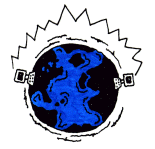
Ionosphere
 The ionosphere is a layer of ionized air in the atmosphere extending from almost 80 km above the Earth's surface altitudes of 600 km and more. Technically, the ionosphere is not another atmospheric layer. It occupies the same region of the upper atmosphere as the thermosphere. In this region of the atmosphere the Sun's energy is so strong that it breaks apart molecules and atoms of air, leaving ions (atoms with missing electrons) and free-floating electrons. The ionosphere is the region of the atmosphere where the aurorae occur.
The ionosphere is a layer of ionized air in the atmosphere extending from almost 80 km above the Earth's surface altitudes of 600 km and more. Technically, the ionosphere is not another atmospheric layer. It occupies the same region of the upper atmosphere as the thermosphere. In this region of the atmosphere the Sun's energy is so strong that it breaks apart molecules and atoms of air, leaving ions (atoms with missing electrons) and free-floating electrons. The ionosphere is the region of the atmosphere where the aurorae occur.
Ionisation of air molecules in the ionosphere is produced by ultraviolet radiation from the Sun, and to a lesser extent by high-energy particles from the Sun and from cosmic rays.
The large number of free electrons in the ionosphere allows the propagation of electromagnetic waves. Radio signals - a form of electromagnetic radiation - can be "bounced" off the ionosphere allowing radio communication over long distances.
Websites
Other topics
• Ionosphere
• Solar-Terrestrial Physics
• Windows to the Universe
• British Antarctic Survey
• Introduction
• Aerosols
• Air
• Air Gases
• Air Layers
• Aurora
• Blue Sky
• Clouds
• Coriolis Force
• Cosmic Rays
• Energy
• Exosphere
• Ionosphere
• Jet Stream
• Magnetosphere
• Mesosphere
• Meteors
• Moisture
• Nitrogen
• Oxygen
• Ozone Hole
• Ozone Layer
• Pollution
• Pressure
• Stratosphere
• Temperature
• Thermosphere
• Trace Gases
• Troposphere
• Weather
• Wind
 Print Topic
Print Topic